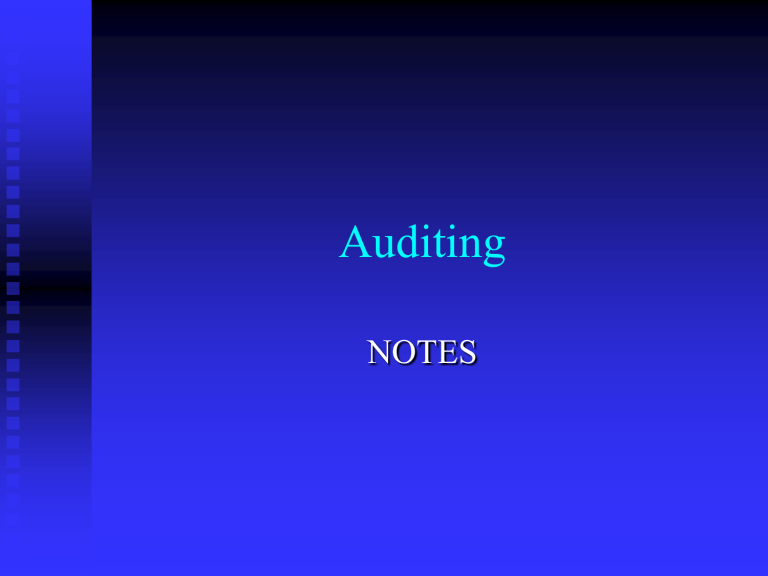
Auditing NOTES Types of Audits 1. 2. 3. 4. Financial Statement Audits Evaluates correspondence between financial statements and GAAP Operational Audits Evaluates correspondence between org’s procedures and methods and criteria of efficiency and effectiveness Compliance Audits Evaluates correspondence between org’s operations and specific procedures or rules Comprehensive Audits Accounting vs. Auditing 1. 2. Accounting Recording, classifying and summarizing of economic events for the purpose of providing financial information for decision making Requires understanding of GAAP Auditing Determining whether recorded information properly reflects the economic events of the period Requires understanding of GAAP AND of accumulation and interpretation of audit evidence Financial Statement Audit Objectives The objective of the audit of financial statements is to express an opinion whether the financial statements present fairly, in all material respects, the financial position, results of operations and changes in financial position in accordance with generally accepted accounting principles. Opinion Fairly Materiality GAAP FUNDAMENTAL CONCEPTS Materiality Something is material if, in auditor’s judgment, its omission or misstatement would probably affect a user’s decision. Audit risk The risk that the auditor may unknowingly provide a “clean” opinion on financial statements that are materiality misstated. “Presents fairly” means that this risk is at an appropriately low level. So, an audit opinion… is NOT an assurance as to the future viability of an entity is NOT an opinion as to the efficiency or effectiveness with which its operations, including internal control, have been conducted Is NOT a guarantee that the financial statements are free of error Benefits of Being Audited 1. 2. 3. Operational Audits Improves efficiency and effectiveness Compliance Audits Reduces cost of non-compliance Reassures external parties Financial Statement Audits May be mandatory Reduces cost of capital. Why?……. Business Risk vs. Information Risk 1. 2. Business Risk Risk that organization will fail to achieve its objectives Information Risk Risk that the information upon which a business decision was made is inaccurate The financial stakeholders of a firm face both types of risk. A financial statement audit reduces information risk, but not business risk Sources of Information Risk Remoteness of Information Voluminous Data Complex Exchange Transactions Bias and Motives of Information Provider Generally Accepted Auditing Standards (GAAS) - General Standard The General Standard "The examination should be performed and the report prepared by a person or persons having adequate technical training and proficiency in auditing, with due care and with an objective state of mind" [Sept 1975] General Standard therefore emphasizes: Competence Objectivity Due Professional Care Generally Accepted Auditing Standards (GAAS) Examination Standards Adequate Planning and Supervision (i) The work should be adequately planned and properly executed. If assistants are employed they should be properly supervised. [Sept. 1975] Generally Accepted Auditing Standards (GAAS) Sufficient Understanding of Internal control (ii) A sufficient understanding of internal control should be obtained to plan the audit. When control risk is assessed below maximum, sufficient appropriate audit evidence should be obtained through tests of controls to support the assessment. Generally Accepted Auditing Standards (GAAS) Sufficient and Appropriate Audit Evidence (iii) Sufficient appropriate audit evidence should be obtained by such means as inspection, observation, enquiry, confirmation, computation and analysis, to afford a reasonable basis to support the content of the report. [Sept. 1975] Quick discussion of Internal Control Control comprises those elements of an organization (including it resources, systems, processes, culture, structure and tasks) that, taken together, support people in the achievement of the organization’s objectives. Objectives relate to: effectiveness and efficiency of operations, including safeguarding of assets reliability of internal and external reporting compliance with applicable laws, regulations, and internal policies
